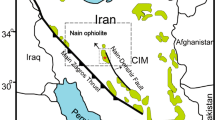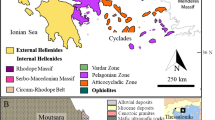Summary
A large number of podiform chromitite bodies of massive, disseminated and nodular type have been located in ultramafic units, composed of depleted mantle harzburgite and dunite of the Marmaris Peridotite from Ortaca (Muğla, SW Turkey). The chromite ore bodies are surrounded by dunite envelopes of variable thickness, exhibiting transitional boundaries to harzburgite host rocks. Chromitites, containing a large number of inclusions, i.e. silicates, base metal sulphides and alloys, and platinum-group minerals (PGM) have a wide range of chemical composition. The Cr# [Cr/(Cr + Al)] values of most chromitites are high (0.61–0.81) and Mg# [Mg/(Mg + Fe2 + )] values range between 0.65 and 0.71 with TiO2 content lower than 0.24 wt.%, which may reflect the crystallization of chromites from boninitic magmas in supra-subduction setting environment.
Platinum-group minerals (PGM) such as laurite, erlichmanite and Os–Ir alloys, silicates such as olivine, clinopyroxene and amphibole, and base metal sulphides (BM-S), alloys (BM-A) and arsenides (BM-As) are found as inclusions in chromite or in the serpentine matrix. Platinum-group element (PGE) concentrations of the Ortaca chromitites (OC) are low in all samples. Total PGE (Ir + Ru + Rh + Pt + Pd) ranges from 63 ng/g to 266 ng/g and Pd/Ir ratios range between 0.23 and 4.75. PGE content is higher and the Pd/Ir ratio lower in Cr-rich chromitites compared to Al-rich ones. There is a strong negative correlation between the Cr# and Pd/Ir ratios (r=−0.930). The PGE patterns show a negative slope from Ru to Pt and a positive slope from Pt to Pd. The low PGE content in the majority of the OC may reflect a lack of sulphur saturation during an early stage of their crystallization. The laurite compositions show a wide range of Ru–Os substitution caused by relatively low temperature and increasing f(S2) during the chromite crystallization. The high Cr# of and hydrous silicate mineral inclusions in chromite imply that chromite crystallized in a supra-subduction setting.
Similar content being viewed by others
Author information
Authors and Affiliations
Rights and permissions
About this article
Cite this article
Uysal, I., Sadiklar, M., Tarkian, M. et al. Mineralogy and composition of the chromitites and their platinum-group minerals from Ortaca (Muğla-SW Turkey): evidence for ophiolitic chromitite genesis. Mineralogy and Petrology 83, 219–242 (2005). https://doi.org/10.1007/s00710-004-0063-3
Received:
Accepted:
Issue Date:
DOI: https://doi.org/10.1007/s00710-004-0063-3




